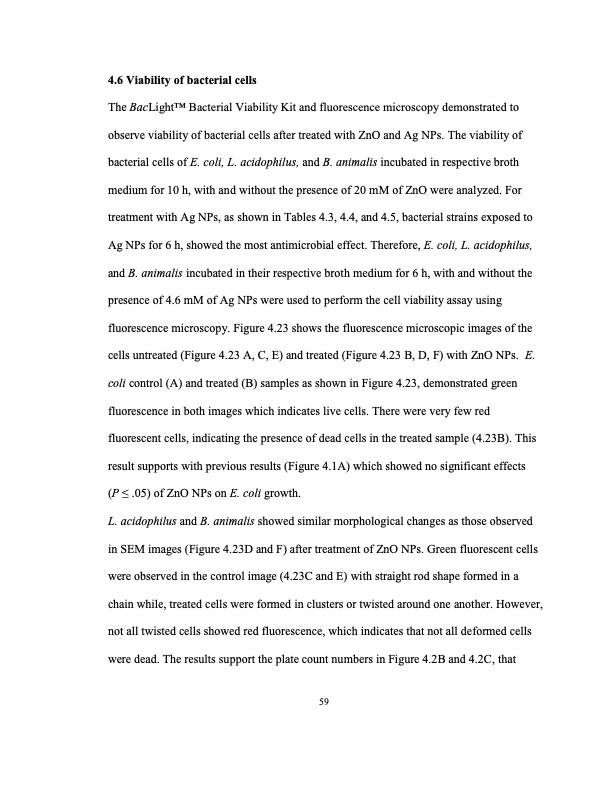
PDF Publication Title:
Text from PDF Page: 070
4.6 Viability of bacterial cells The BacLightTM Bacterial Viability Kit and fluorescence microscopy demonstrated to observe viability of bacterial cells after treated with ZnO and Ag NPs. The viability of bacterial cells of E. coli, L. acidophilus, and B. animalis incubated in respective broth medium for 10 h, with and without the presence of 20 mM of ZnO were analyzed. For treatment with Ag NPs, as shown in Tables 4.3, 4.4, and 4.5, bacterial strains exposed to Ag NPs for 6 h, showed the most antimicrobial effect. Therefore, E. coli, L. acidophilus, and B. animalis incubated in their respective broth medium for 6 h, with and without the presence of 4.6 mM of Ag NPs were used to perform the cell viability assay using fluorescence microscopy. Figure 4.23 shows the fluorescence microscopic images of the cells untreated (Figure 4.23 A, C, E) and treated (Figure 4.23 B, D, F) with ZnO NPs. E. coli control (A) and treated (B) samples as shown in Figure 4.23, demonstrated green fluorescence in both images which indicates live cells. There were very few red fluorescent cells, indicating the presence of dead cells in the treated sample (4.23B). This result supports with previous results (Figure 4.1A) which showed no significant effects (P ≤ .05) of ZnO NPs on E. coli growth. L. acidophilus and B. animalis showed similar morphological changes as those observed in SEM images (Figure 4.23D and F) after treatment of ZnO NPs. Green fluorescent cells were observed in the control image (4.23C and E) with straight rod shape formed in a chain while, treated cells were formed in clusters or twisted around one another. However, not all twisted cells showed red fluorescence, which indicates that not all deformed cells were dead. The results support the plate count numbers in Figure 4.2B and 4.2C, that 59PDF Image | ZINC OXIDE AND SILVER NANOPARTICLES ON INTESTINAL BACTERIA

PDF Search Title:
ZINC OXIDE AND SILVER NANOPARTICLES ON INTESTINAL BACTERIAOriginal File Name Searched:
thesis-zinc-oxide-silver-nano.pdfDIY PDF Search: Google It | Yahoo | Bing
Turbine and System Plans CAD CAM: Special for this month, any plans are $10,000 for complete Cad/Cam blueprints. License is for one build. Try before you buy a production license. More Info
Waste Heat Power Technology: Organic Rankine Cycle uses waste heat to make electricity, shaft horsepower and cooling. More Info
All Turbine and System Products: Infinity Turbine ORD systems, turbine generator sets, build plans and more to use your waste heat from 30C to 100C. More Info
CO2 Phase Change Demonstrator: CO2 goes supercritical at 30 C. This is a experimental platform which you can use to demonstrate phase change with low heat. Includes integration area for small CO2 turbine, static generator, and more. This can also be used for a GTL Gas to Liquids experimental platform. More Info
Introducing the Infinity Turbine Products Infinity Turbine develops and builds systems for making power from waste heat. It also is working on innovative strategies for storing, making, and deploying energy. More Info
Need Strategy? Use our Consulting and analyst services Infinity Turbine LLC is pleased to announce its consulting and analyst services. We have worked in the renewable energy industry as a researcher, developing sales and markets, along with may inventions and innovations. More Info
Made in USA with Global Energy Millennial Web Engine These pages were made with the Global Energy Web PDF Engine using Filemaker (Claris) software.
Infinity Turbine Developing Spinning Disc Reactor SDR or Spinning Disc Reactors reduce processing time for liquid production of Silver Nanoparticles.
| CONTACT TEL: 608-238-6001 Email: greg@infinityturbine.com | RSS | AMP |